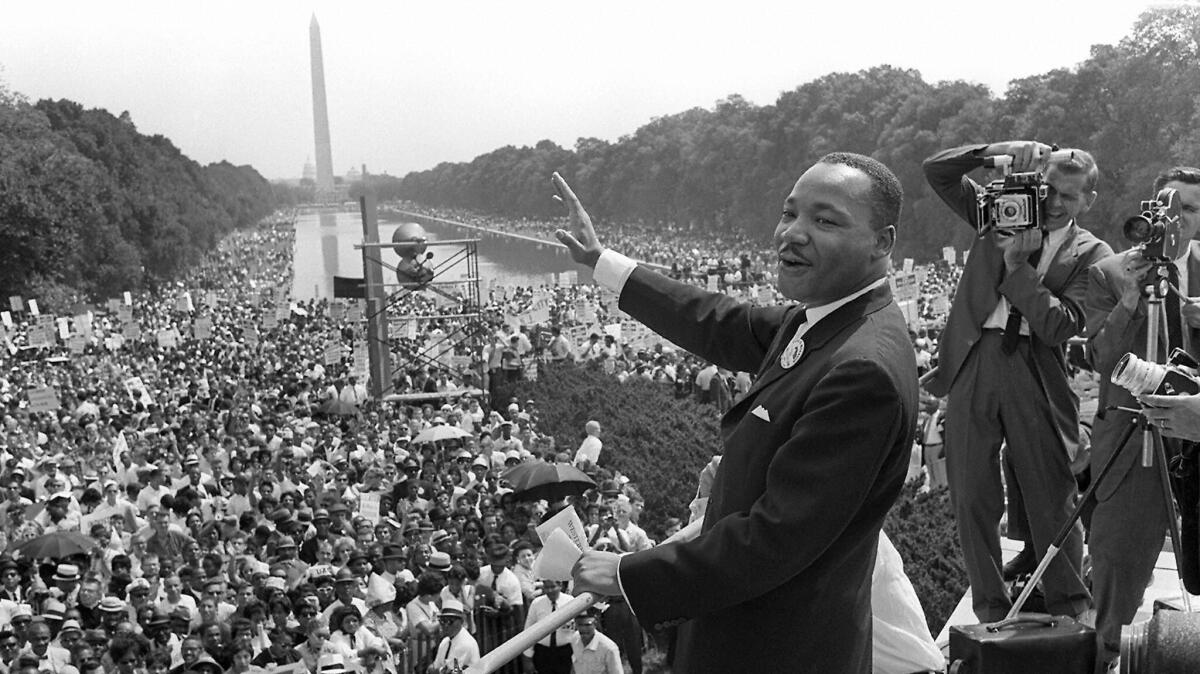Like a great pink-capped wave, rolling from one edge of the country to the other, more than a million protesters marched through the streets of America on Saturday in an unprecedented show of discontent scarcely a day into the new Trump administration.
From resort towns like Bend, Ore., to the skyscraper-lined streets of New York City, it was an outpouring that surely gladdened critics of President Trump and lifted the faint spirits of Democrats crushed by his upset victory.
But once the protest signs come down and buoyant marchers tuck their “pussy hats” away in their closets, what remains is a stark reality facing the left-leaning throngs: a government in Washington run by the GOP and more than 30 state capitals where Republicans enjoy unchecked control.
Politically, that is the kind of breakwater that can dash the strongest wave.
In an age of supposed apathy and Twitter-sized attention spans, the spectacle of so much humanity rising in dissent makes for striking imagery. It also sent a message.
“There really is no expectation that Trump is going to be turned out of office,” said Kathleen Rodgers, a University of Ottawa professor who wrote a book on protest and politics. “But it does send a reminder that, look, if you do something they don’t like,” millions stand ready to object.
What was particularly noteworthy, said Rodgers, one of several thousand Canadians who marched through their capital in solidarity with American demonstrators, was the apparently large number of newcomers. “The fact they turned out means they’re more likely to participate again later,” said Rodgers.
The key to political change, she and others pointed out, is that sort of continued engagement.
The tea party started as a protest against the bailouts and other relief measures designed to rescue the country from the Great Recession. It gained strength, and proved President Obama’s most nettlesome foe, because its members not only turned out at rallies, town hall meetings and, eventually, a huge Washington rally, but also voted, persistently and in significant numbers.
Some acolytes even ran for office and now sit in Congress and on city councils and school boards across the country.
“A big turnout is good,” said David Meyer, a UC Irvine sociologist, who has also written extensively on political protest and social movements. “But sustained action is the real question.”
It will be years before it is clear whether Saturday’s demonstrations were the start of a paradigm-shifting political movement or the equivalent of a mass therapy session adorned with liberal celebrities and pink knit caps — a puckish play on Trump’s crude reference to women.
History offers several examples of protests that proved consequential and others much less so.
Bonus Army March on Washington
Tens of thousands of protesters, many of them World War I veterans and their families, descended on Washington in the summer of 1932 to pressure Congress to pass legislation awarding them deferred bonuses they desperately needed to weather the Depression.
When the protest turned violent, Army troops led by Douglas MacArthur used tear gas and bayonets to roust the demonstrators, producing a backlash that further turned the country against President Hoover. He lost the November election to New York Gov. Franklin D. Roosevelt.
March on Washington for Jobs and Freedom
Best remembered for the Rev. Martin Luther King Jr.’s “I Have A Dream” speech, the 1963 gathering in support of civil rights was decades in the making and highly discouraged by the country’s political leaders, including President Kennedy.
The defiant but peaceable assembly of hundreds of thousands of African Americans and their supporters, who endured stifling August heat, confounded critics and helped prod congressional passage of civil rights legislation.

Moratorium to End the War in Vietnam
On Oct. 15, 1969, with more than half a million troops fighting in Southeast Asia and no end in sight, an estimated 2 million people across the country marched in one of the largest demonstrations in U.S. history. The protests did not end the war, or unify the country in any fashion, though it underscored the growing resistance beyond college campuses to the conflict in Vietnam.
The war dragged on for another six years, and the credibility gap it opened between Washington and much of the rest of the country has only increased.
Million Man March
Organized chiefly by the Nation of Islam and its controversial leader, Louis Farrakhan, the 1995 rally drew hundreds of thousands of black men to Washington in a show of pride and solidarity. It is hard to argue that the march bettered race relations in the country or ameliorated troubles facing the black community.
A lasting legacy is controversy over the crowd count. The National Park Service estimated the turnout at 400,000, which experts now consider too low. Organizers accused the park service of racism and threatened to sue; as a result of the dispute, Congress barred the service from offering crowd counts. Today’s estimates — really rough guesses — come from local law enforcement and transit officials.
ALSO
Hundreds of thousands of marchers trek through Washington in a passionate display for women’s rights
Massive women’s march in downtown L.A. said to be largest in over a decade